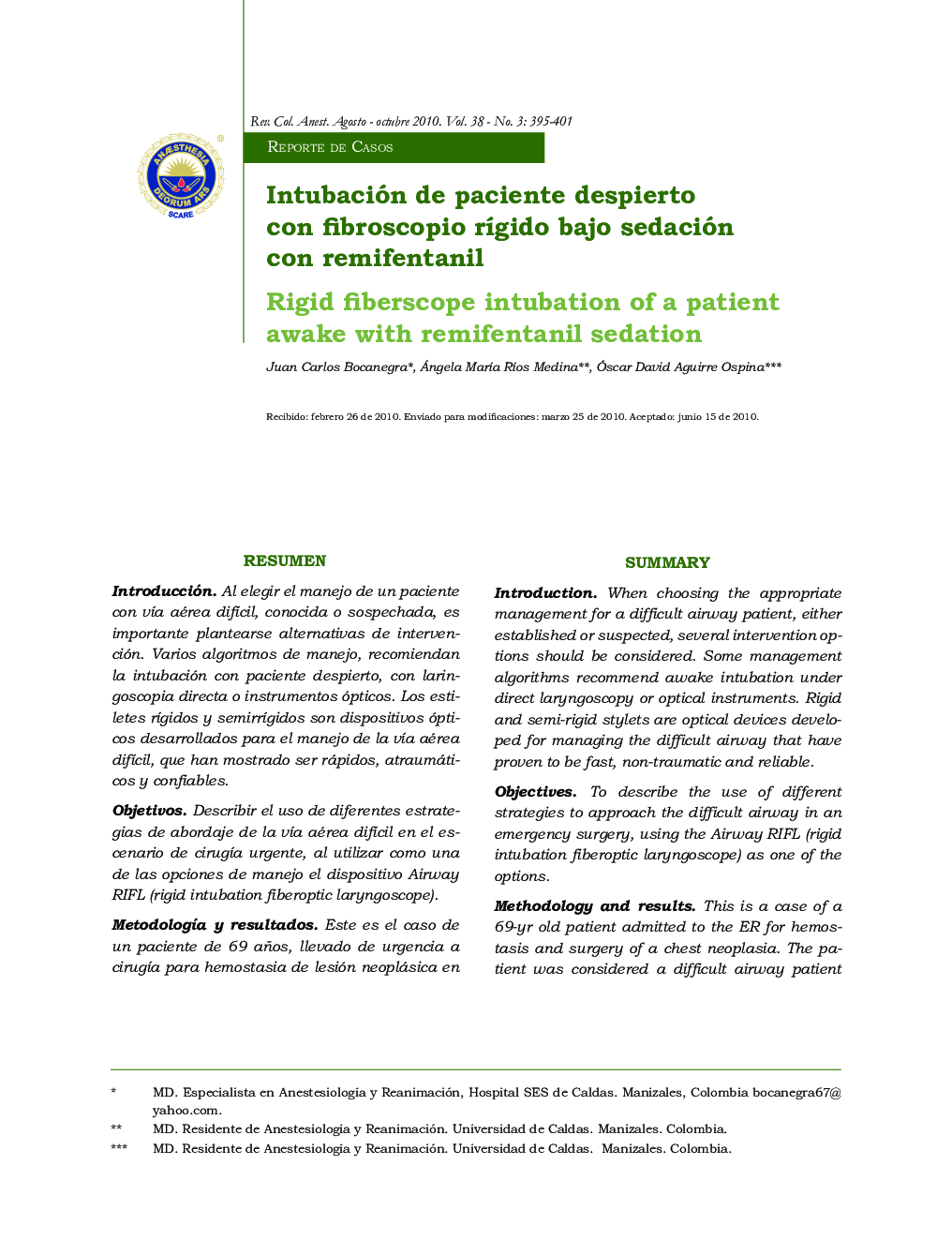| Article ID | Journal | Published Year | Pages | File Type |
|---|---|---|---|---|
| 2768128 | Revista Colombiana de Anestesiología | 2010 | 7 Pages |
RESUMENIntroducciónAl elegir el manejo de un paciente con vía aérea difícil, conocida o sospechada, es importante plantearse alternativas de intervención. Varios algoritmos de manejo, recomiendan la intubación con paciente despierto, con laringoscopia directa o instrumentos ópticos. Los estiletes rígidos y semirrígidos son dispositivos ópticos desarrollados para el manejo de la vía aérea difícil, que han mostrado ser rápidos, atraumáticos y confiables.ObjetivosDescribir el uso de diferentes estrategias de abordaje de la vía aérea difícil en el escenario de cirugía urgente, al utilizar como una de las opciones de manejo el dispositivo Airway RIFL (rigid intubation fiberoptic laryngoscope).Metodología y resultadosEste es el caso de un paciente de 69 años, llevado de urgencia a cirugía para hemostasia de lesión neoplásica en tórax, considerado como vía aérea difícil por antecedente de múltiples resecciones de lesiones tumorales y radioterapia en vía aérea, con secuela de marcada deformidad facial. Intubación con estómago lleno. Se plantea como primera opción en el manejo de la via aérea el uso de anestesia tópica, sedación con remifentanil y laringoscopia directa, lo cual no es posible por limitada apertura oral: se intenta en tres ocasiones intubación nasal, la cual es fallida. Se decide intubación con el dispositivo Airway RIFL, la cual es exitosa.ConclusionesDentro del enfoque del paciente considerado como vía aérea difícil, contar con varias estrategias de manejo, la analgesia local y la sedación, permiten una excelente colaboración por parte del paciente y una rápida intubación orotraqueal con fibroscopio rígido, incluso en escenarios de urgencia.
SUMMARYIntroductionWhen choosing the appropriate management for a difficult airway patient, either established or suspected, several intervention options should be considered. Some management algorithms recommend awake intubation under direct laryngoscopy or optical instruments. Rigid and semi-rigid stylets are optical devices developed for managing the difficult airway that have proven to be fast, non-traumatic and reliable.ObjectivesTo describe the use of different strategies to approach the difficult airway in an emergency surgery, using the Airway RIFL (rigid intubation fiberoptic laryngoscope) as one of the options.Methodology and resultsThis is a case of a 69-yr old patient admitted to the ER for hemostasis and surgery of a chest neoplasia. The patient was considered a difficult airway patient because of a history of multiple tumor resections and radiotherapy in the airway, resulting in a notorious facial deformity. Intubation on a full stomach. Topical anesthesia was considered the first choice for airway management, remifentanil sedation and direct laryngoscopy but this is not possible due to a limited oral opening: three nasal intubation attempts were made but failed. Then it was decided to use the Airway RIFL device and the procedure was successful.ConclusionsWhen dealing with a difficult airway patient, having several management strategies at hand, local anesthesia and sedation, allow for excellent patient collaboration and a fast orotracheal intubation using a rigid fiberscope, even under emergency situations.
